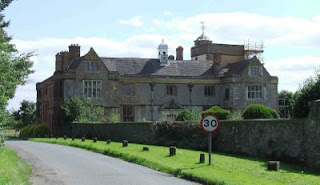Friday, June 7, 2013
Canons Ashby, Northamptonshire
Backward glance (4): Finding Canons Ashby
This backward glance recalls another discovery of my teenage years. The big house seemed abandoned back then, but at least it had escaped the great cull of country houses that had taken place in the 1950s and 1960s. I'm glad the place was saved by the National Trust, although one of its literary connections still nags away at me – although I did read Pamela once, I've never made much headway with the novels of Samuel Richardson...
I remember when I first stumbled across this place. Passing a knot of stone outbuildings and rounding a sharp bend, there was a high brick wall pierced with mullioned windows. As we continued a little further and pulled up by the side of the lane, this beautiful front was revealed across a lawn. We had found Canons Ashby.
All those years ago, the house looked neglected and sad. Walls were bowing. I think I remember weeds sprouting from the fabric here and there. We poked around a bit and a local woman appeared from a nearby cottage. We learned that Canons Ashby was the ancestral home of the Drydens (the poet’s family), who had lived here since the 17th century, but who now lived in Africa. As the sun warmed the Northamptonshire stone and and brought out colours ranging from raspberry to apricot in the brickwork, the place looked magical. Inside, we were told, nothing much had changed for 250 years. And all this history looked as if it would soon turn into another ruin, another lost country house.
That it did not do so was mostly due to Gervase Jackson-Stops, architectural advisor to the National Trust and a great scholar of and friend of country houses. Jackson-Stops not only fought to save the place, but also pioneered an arrangement under which government money was used to endow a house given to the National Trust – the first time the Trust had accepted a building with this source of endowment.
The place has blossomed since it was taken under the National Trust’s wing in 1981. The dry rot is gone, the structure has been strengthened, and conservators working for the Trust discovered enchanting 16th-century murals under layers of paint, to add to delights ranging from elaborate plaster ceilings to the vast kitchen, which, until 1938 contained the only tap (cold, of course) in the house. The library even houses a signed copy of Sir Charles Grandison by Samuel Richardson, one of the fathers of the English novel. Apparently he wrote the book at Canons Ashby: another literary link. It’s heartening to know that the fragile beauty of this place has been saved.
Subscribe to:
Post Comments (Atom)




2 comments:
Canons Ashby, what a wonderful name. You couldn't make it up could you? Although, of course, someone once did!
Bazza’s Blog ‘To Discover Ice’ is back. Click here for thrills!
Evidently quite a wealth of history and literary legacy associated with this appealing building. I sense fans of Jane Austen lament the ruins of a well which are all that remain of the old rectory in Steventon where the Austens once lived. Looking at this photo of Canons Ashby I feel the sense of timelessness is fractured by the rather importunate placement of the 30mph sign; I think I might ask the council if they could kindly move it 20 metres to the right.
Post a Comment